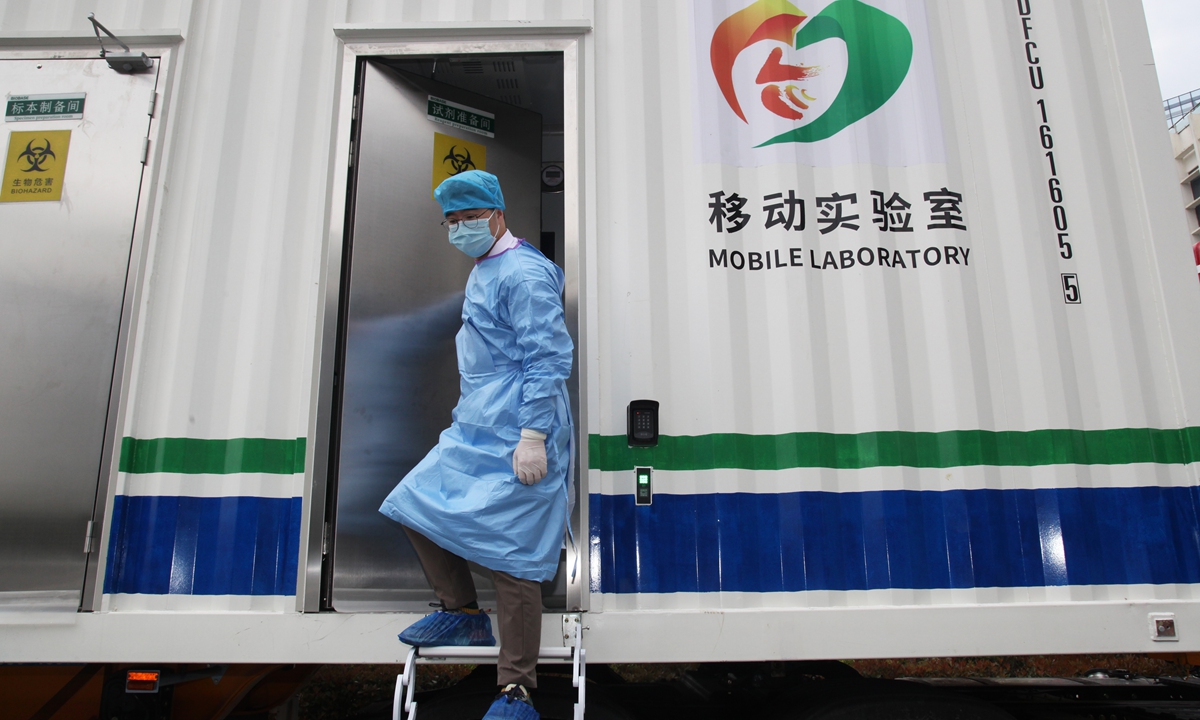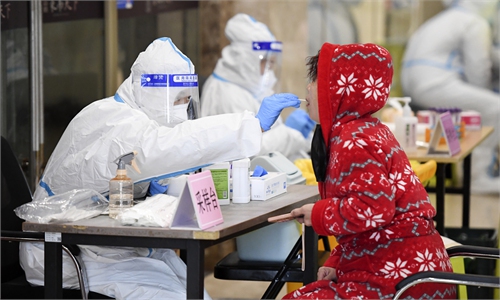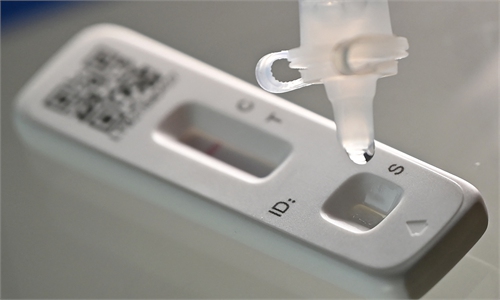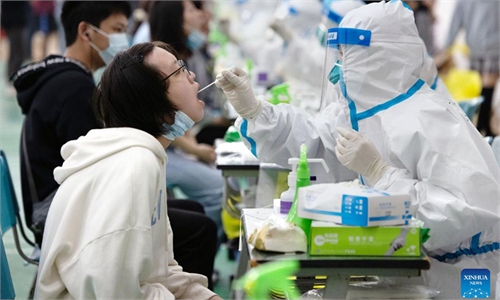
A staff member walks out of a mobile lab for COVID-19 nucleic acid testing in Taizhou,East China's Zhejiang Province on March 17, 2022. Photo: IC
Chinese President Xi Jinping on Thursday chaired a leadership meeting on fighting COVID-19, in which he stressed science-based and accurate measures and the adherence to the dynamic zero-COVID policy to curb the spread of the epidemic soonest.
Top epidemiologists hailed this meeting as injecting the much-needed "anchoring energy" into China's COVID-19 prevention work as it currently battles the "worst outbreaks" in two years caused by the highly contagious Omicron variant. They believed that as China adheres to its dynamic zero-COVID strategy, which is still the biggest advantage China currently has in its COVID-19 battle, the country is also stepping into a "more balanced and scientific" stage of fighting the virus, following the plan drawn by the new COVID-19 playbook.
Xi, who is also general secretary of the Communist Party of China (CPC) Central Committee, made an important speech at Thursday's meeting of the Standing Committee of the Political Bureau of the CPC Central Committee.
"Victory comes from perseverance," Xi said. He asked all departments and regions to prepare for complexity and difficulty in COVID-19 response at home and abroad.
Xi called for further scientific and technological innovation in research and development of vaccines, rapid testing reagents, and medicines to make the prevention and control more targeted.
More effective measures should be taken to achieve maximum effect in prevention and control with minimum cost, and to reduce the epidemic's impact on socioeconomic development as much as possible, Xi said.
The meeting also urged officials not to loosen vigilance and stated that officials found to be in dereliction of duty would be held accountable.
In April 2020, Xi also emphasized virus prevention, and resumption of work and production in a meeting of the Standing Committee of the Political Bureau of the CPC Central Committee he chaired.
This meeting has injected the much-needed "anchoring energy" into the current work to fight COVID-19, as the country is fighting a hard battle against the highly contagious Omicron variant, an expert from Chinese Center for Disease Control and Prevention (Chinese CDC), who requested anonymity, told the Global Times.
He said that Xi's remarks have requested the whole society not to loosen COVID-19 prevention and to fix the loopholes in current virus prevention work.
China has recorded some 20,000 domestically transmitted infections since March 1, affecting 28 provincial-level regions.
More than 60 local officials in provinces including Jilin, Guangdong and Shandong have been punished during this round of outbreaks for their dereliction in the COVID-19 prevention and control.
Cases nosedive
Cases have nosedived in the last two days, with the Chinese mainland detecting 1,226 new locally transmitted cases on Wednesday, and another 1,206 silent carriers. On Tuesday, 1,860 confirmed cases were recorded. The number was half the caseload recorded on Monday, which topped 3,500.
These quick declines occurred after places facing an onslaught of the coronavirus, including Shanghai, Shenzhen and Jilin, took stringent measures to curb viral transmission. For example, Jilin, the hot spot of this round of outbreaks, announced on Monday that residents were forbidden from leaving the province effective immediately, and was racing against time to build makeshift hospitals to receive patients.
Jilin, the province that recorded four-digit caseloads for four consecutive days, detected 742 confirmed cases on Wednesday. Yang Junlin, a medical expert in Jilin, said at the provincial government's daily COVID-19 briefing on Thursday that most patients with mild or no symptoms are getting better.
She noted that 95 percent of the cases detected in the current outbreak in Jilin are asymptomatic or have only mild symptoms.
Huang Qiang, an official from the government of Shenzhen, said during a Thursday conference that some areas that had previously been savaged by the virus had found no infections within communities. Shenzhen is undergoing a seven-day lockdown from March 13 to 20.
Wang Guangfa, a respiratory expert at Peking University First Hospital, described this wave of the outbreaks, which are mainly caused by the highly contagious yet more concealed Omicron variant and its strains, as the "most dangerous one" in the past two years.
"The fact that the cases dropped so fast and so soon proved that dynamic zero-COVID policy is still China's most effective tool in fighting the COVID-19, and a guarantee for people's lives to return to normal as soon as possible," Wang noted.
A more scientific road
While sticking to a dynamic zero-COVID strategy, China is also making great strides toward what epidemiologists call "scientific and pragmatic" adjustment in fighting the virus, as it updated its COVID-19 playbook on Tuesday, ordering COVID-19 patients with mild symptoms to go to centralized quarantine facilities instead of hospitals, and lowering the requirements for patients to be discharged from hospitals.
Speaking at a Thursday conference, Zhang Wenhong, head of the Shanghai panel overseeing the treatment of COVID-19, said that the updated plan has won praise from professional medical workers, and which he called a "strategic adjustment."
He said that the new playbook, which emphasizes the categorized treatment of patients in different situations, will free up more medical resources for patients with severe symptoms.
A large proportion of patients during this wave of outbreaks have turned out to be asymptomatic. Zhang explained that as these silent carriers can pass the virus to others, they still need to undergo collective quarantine, along with patients with mild symptoms.
He revealed that medical experts in Shanghai are already discussing adapting to the new adjustment. "Hopefully the day [for implementing those new measures] will come early," said Zhang.
Zeng Guang, the former chief epidemiologist of CDC, told the Global Times on Wednesday that the adjustments are particularly applicable in areas where the virus is rife.
Lu Hongzhou, director of the Shenzhen Third People's Hospital, told the Global Times on Thursday that Shenzhen has been following the latest COVID-19 playbook by putting people with mild symptoms under centralized quarantine instead of sending them to hospitals, and lowering the requirements for patients to be discharged.
More patients have been discharged according to the new standard, releasing more beds for new severe cases, Lu said.
Antigen tests have also been put into use. Shenzhen residents, if feeling uncomfortable, can conduct quick antigen self-tests in addition to nucleic acid tests, Lu said.
Epidemiologists said that the changes should in no way be interpreted as China "lying down" in the face of surging cases, or "downgrading" its dynamic zero-COVID standard. Zeng said that the changes are being made in accordance with the characteristics of Omicron, which causes mild symptoms, but our precautions for COVID-19 control cannot be loosened.
Zhang said that three "weapons" are needed in the future fight with the coronavirus - sufficient vaccinations, effective medicines and abundant medical resources.



